Soaring on the Wings of Giants—35 Years of the Taiwan Wild Bird Federation (Part 3)
By Scott Pursner, TWBF Director of International Affairs
Part 3: Growth and Change in the New Millenium (2001-2015)
Expanding Scope (2001-2005)
The first year of the new millennium brought both sweetness and bitterness to the TWBF. The sweet came in the form of the publication of its first book dedicated to IBAs. It was also in this year that Taiwan finally published its own Taiwan Red Data Book created with information from the TWBF. However, the bitter came with the destruction of almost all copies and electronic files by Typhoon Nari when it hit Taiwan in September 2001 (24). The volumes were part of the large amounts of materials in the TWBF office destroyed by water damage caused by the storm. The only hard copy to survive was held by Dr. Fang Woei-horng, who had gone to the office to collect his copy early. He also had a near complete electronic file at home (8). He would go on to use these materials to review the data from the initial version. A new Taiwan Red Data Book would be published in 2004. On behalf of the TWBF Fang, who would later go on to serve as one of TWBF's presidents, also created a popular science version of the book for general audiences. Titled A Guide to Threatened Birds of Taiwan, the book highlighted species found in Taiwan which were listed by the International Union for the Conservation of Nature (IUCN) as globally threatened, as well as those which Taiwan's central government had listed as threatened domestically. He was guided in the work by famed ornithologist Dr. Nigel Collar and then-BirdLife International Asia Division head Richard Grimmett. This was also the year the federation changed its English name to the Wild Bird Federation Taiwan.

The TWBF Office clean-up team after Typhoon Nari hit in 2001 (Source: TWBF Archives)
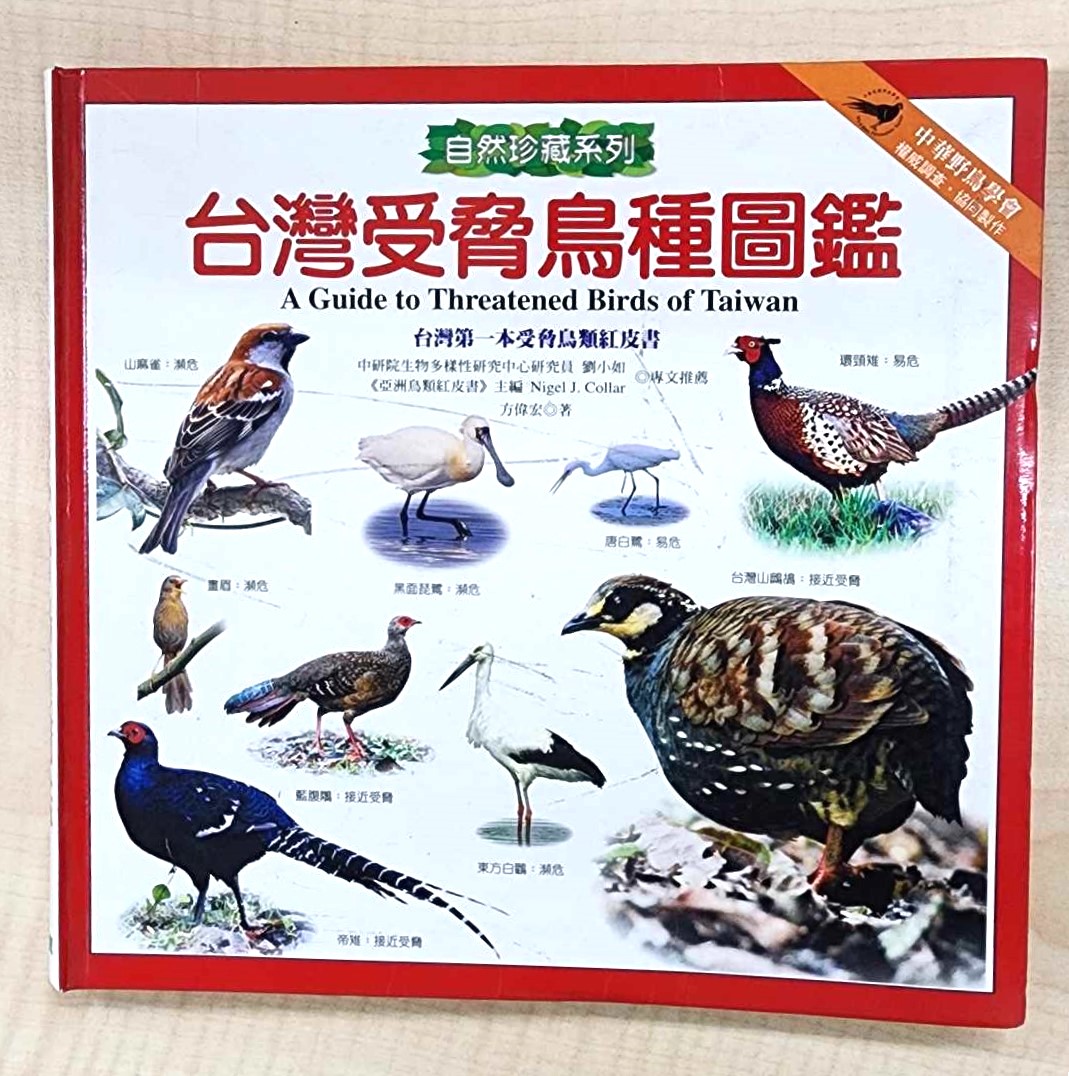
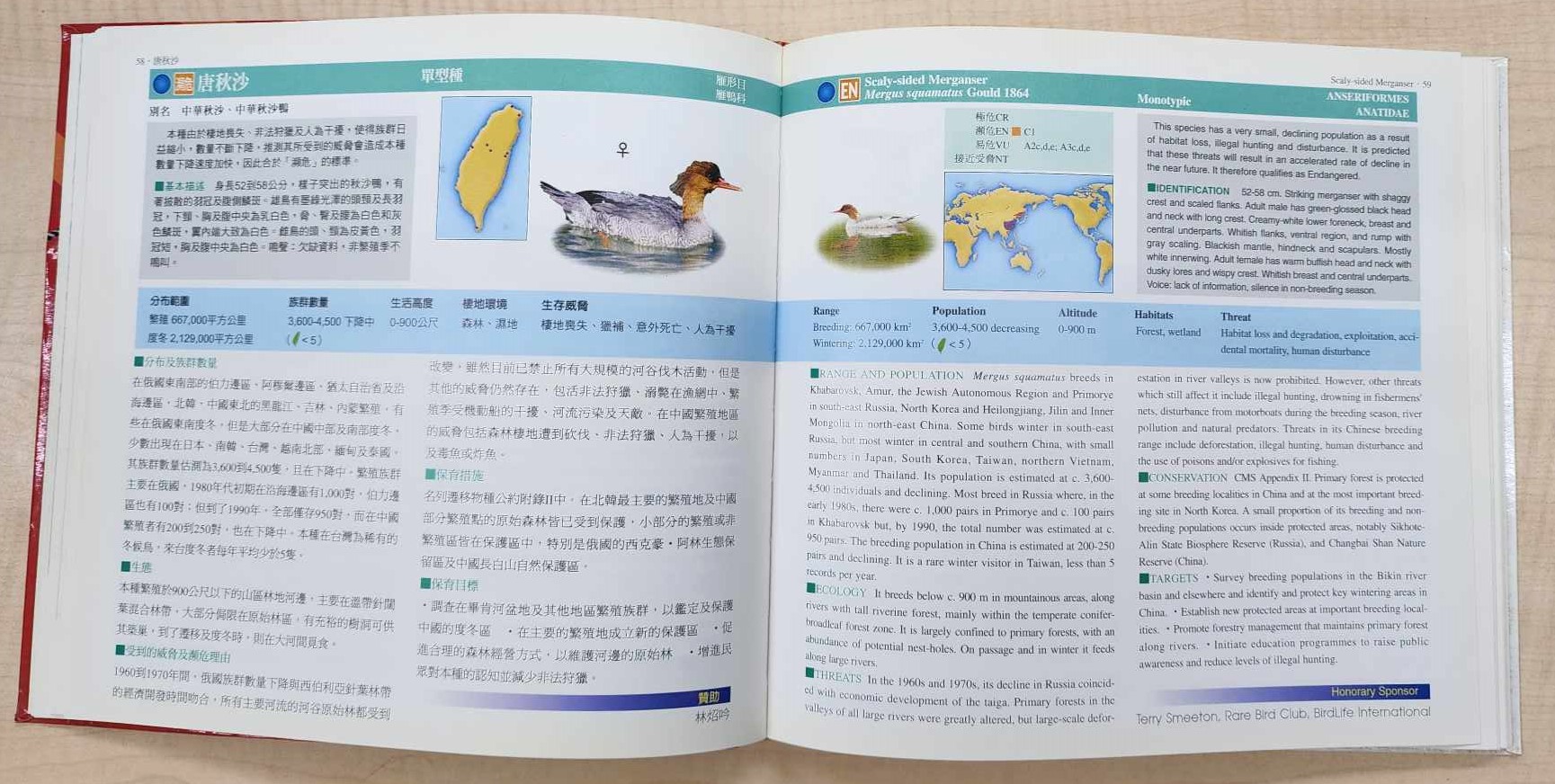
A Guide to Threatened Birds of Taiwan (Source: TWBF Archives)
One of Taiwan's biggest conservation actions in 2001 took place on December 1, when the Taipei City government handed over management of the Guandu Nature Park to the WBS Taipei, making it the first protected area in Taiwan to be managed by an NGO (11). The area of 57 ha was already declared an IBA site due to its importance to migratory birds. The birdwatching event held there beginning in 1999 would henceforth be called the Guandu International Birdwatching Fair. Also, based on the reputation and good work done with Guandu Nature Park, a few years later, the city of Taipei also asked WBS Taipei to help manage the Zhishan Cultural and Ecological Park (31, 32).
In late 2001, Fang accompanied fellow board member C.C. Cheng and TWBF president Simon Liao to Nepal for the BirdLife Asia Representatives meeting. At that meeting, one of the topics discussed was seabird bycatch in longline tuna fleets (25). Liao discussed how the organization had learned of the issue at the 2000 British Bird Fair, when the theme was "Save the Albatross Campaign." He also explained that since then, the group had expressed to the government that it should do more as a responsible and globally important fishing country.
Returning from this meeting, the federation began to work more with the BirdLife International Marine Programme on the topic. In fact, less than a year later, in August 2002, Mr. Leon Viljeon and Dr. Deon Nell were joined by the then-head of the BirdLife International Asia Division Dr. Ishida Noritaka to visit Taiwan and hold talks on seabird bycatch-related work. The TWBF organized meetings for the experts with the Taiwan Fisheries Agency and Taiwan Tuna Association as well as education sessions on the topic for the Wild Bird Society of Taipei and Kaohsiung Wild Bird Society (26). These discussions and the positive results they fostered led to a stronger collaboration between the TWBF and the Marine Programme, which would continue into the future in the form of training for Taiwanese fisheries observers and translation of mitigation measures. In 2004, the TWBF, TFA and Birdlife International hosted a meeting in Kaohsiung to discuss the issue, with experts from the US, Japan, and Birdlife International all taking part (4). This led to a government-supported two-week visit by then-TWBF President C.C. Cheng to Mauritius to interview Taiwanese vessel captains and discuss seabird bycatch issues. In total he talked with crew members from 22 vessels and discovered useful information from the skippers about their use of seabird bycatch mitigation measures (19).
The 7th BirdLife Asia Council Meeting Group Photo (Source: TWBF Archives)
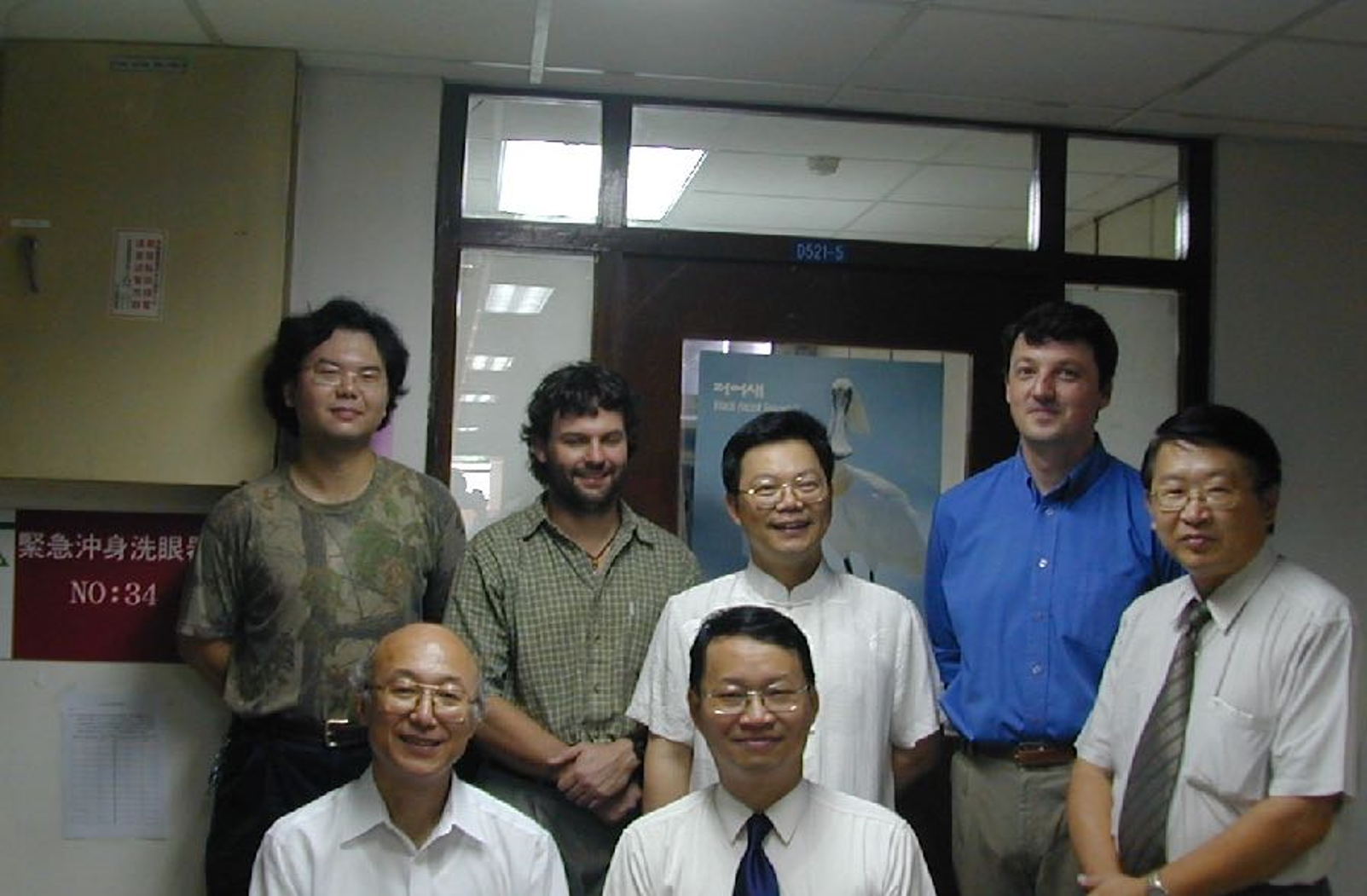
Mr. Leon Viljeon, Dr. Deon Nel,l and then-head of BirdLife International Asia Division Dr. Ishida Noritaka visit Taiwan for talks on seabird bycatch-related work, August 2002 (Source: TWBF Archives)
The next few years saw continuations of the projects and activities initiated in the previous years. This included researcher Scott Lin of the Taiwan Biodiversity Research Institute working with the TWBF's partner network to experiment with citizen science in Fairy Pitta surveys. In 2002, BirdLife International worked with TWBF and the Kaohsiung Wild Bird Society to host the BirdLife International First Conference on Ecotourism with the theme of "Can Ecotourism Help Save Biodiversity?" Held in Kaohsiung City, international participants include the Malaysia Nature Society, Bird Conservation Society of Thailand, Haribon Foundation, Nature Society Singapore, and Society for the Protection of Nature in Israel.
The BirdLife International First Conference on Ecotourism with the theme of "Can Ecotourism Help Save Biodiversity?" was held in Kaohsiung City in 2002 (Source: TWBF Archives)
By this time, Taiwan was catching up with the rest of the world in terms of its flourishing civic groups, with other government organizations and NGOs forming and filling in information gaps. For instance, the Raptor Research Group of Taiwan, founded in 1994 by scientists and raptor enthusiasts, began to work with Kenting National Park in 2004 to survey migratory raptors at the bottleneck of the Kenting Peninsula (16). Every year, hundreds of thousands of migratory Chinese Sparrowhawks and tens of thousands of Grey-faced Buzzards transit through this area on their southern migration. Now Taiwan was doing the work to be able to share this information with the global community.
In 2005, Taiwan hosted the 27th Meeting of the International Waterbird Society in Tainan. The Waterbird Society is an international scientific society that focuses on the science of avian disease and conservation. The theme of the conference that year was Avian Disease and the Migration of Birds. It was supported by the Council of Agriculture and Tainan City Government. Sponsors included the Waterbird Society, the US Geological Society, the International Crane Foundation, BirdLife International and the TWBF (21). In total, 400 scholars and conservationists attended the meeting, the first of its kind in Asia. Taiwan was even called a model for the rest of Asia for its attitude and diligence in conservation work (21).
Shifting Winds (Late 2000s)
During the second half of the 2000s Victor Yu, served as the secretary-general of the federation. During his time there, from 2006-2011, he said changes were taking place in the efforts of the TWBF and its partners. For instance, TWBF during this time was helping its partners with information sharing, education and outreach work, and improving birdwatching and bird survey skills. Yu led the TWBF in helping its partners act on their growing interest in forest birds and shorebirds. He mentioned that, at the request of BirdLife Asia, a Japanese Paradise Flycatcher survey was conducted in 2005 and 2006 in the northeast coast's Yehliu area (28). The site was important given that the global population of the species was then less than 2,000, and around 500 would stop over in Taiwan for one week in March or April each year as they migrated from Indonesia to Japan. The results lead to the eventual development of a Paradise Flycatcher Protection Area (21).
The TWBF also helped organize the International Conservation Action Seminar for Chinese Crested Terns in July 2007. Invited guests included BirdLife International, bird experts from Zhejiang Province in China, and local researchers. The goal was to share information on current work and achievements related to CCT conservation, discuss designation of tern protection areas, and devise a future action plan for conserving the Chinese Crested Tern.
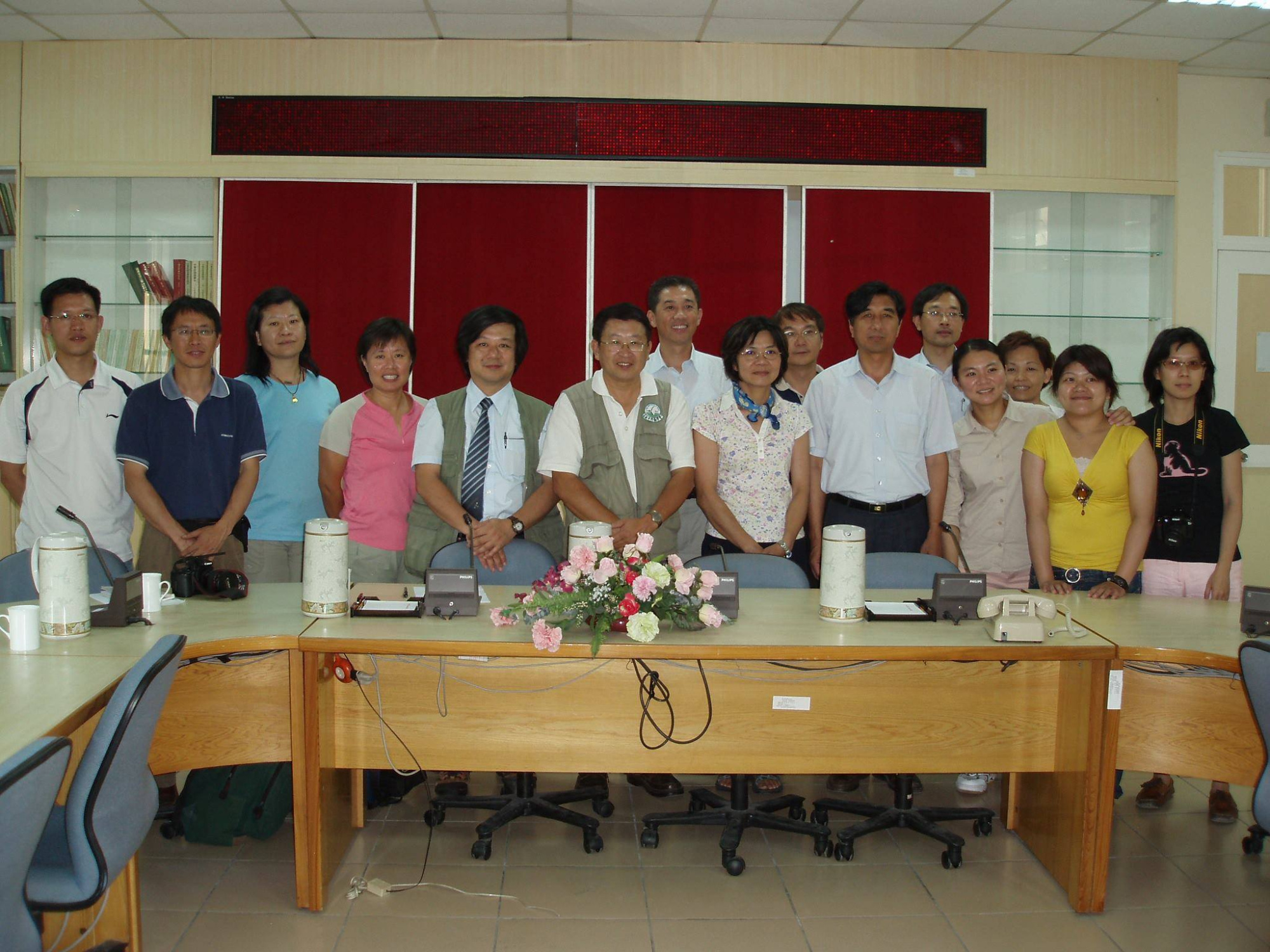
The International Conservation Action Seminar for Chinese Crested Terns in Taipei, July 2007 (Source: TWBF Archives)
The same year, as part of efforts to combat seabird bycatch, the federation collaborated with the World Wildlife Fund and the Taiwan Fisheries Agency to hold the 2007 International Smart Gear Competition, which highlighted new gear, ideas, and technologies to help combat fishing bycatch (27).
In 2008, as the federation celebrated its 20th anniversary, it was still working to fulfill its founding promise to help represent its partners to the government and internationally and provide a stronger unified voice for local bird societies. The TWBF also coordinated and organized national-level surveys, the certification of IBAs, and the Taiwan Black-faced Spoonbill Census, which was done in collaboration with the International Black-faced Spoonbill Census coordinated by the Hong Kong Bird Watching Society. By this point, many research projects were run by professors at universities or government agencies. Yet the bird societies, rooted in local culture and formed by local people, helped to show the value of people power, and had a role in society different from other groups. They could help academics with their research, press government agencies for change, and mobilize people on the ground.
The first Taiwan Bird Forum was held as part of the 20th anniversary festivities. In the words of the TWBF's current secretary-general Allen Lyu, it was "a major event where reports and talks on birds, bird study and ornithology were made." In college at the time, he attended the meeting along with others interested in birds. He also explained that prior to this, in the late 1990s, "The TWBF had held a similar event, the Taiwan Bird Conference (6). First held in 1997, it was a major ornithological meeting, with both professors and bird society members presenting and attending. It highlighted the closeness of the scientific and birder communities at that time.' Though the Taiwan Bird Forum only lasted from 2008-2014, it inspired the Kaohsiung Wild Bird Society and other groups located in the south to create another event which looks specifically at issues facing birds in southern Taiwan. This event, aptly named the Southern Bird Forum, was started just two years later in 2010 (10). It continues to be held to this day.
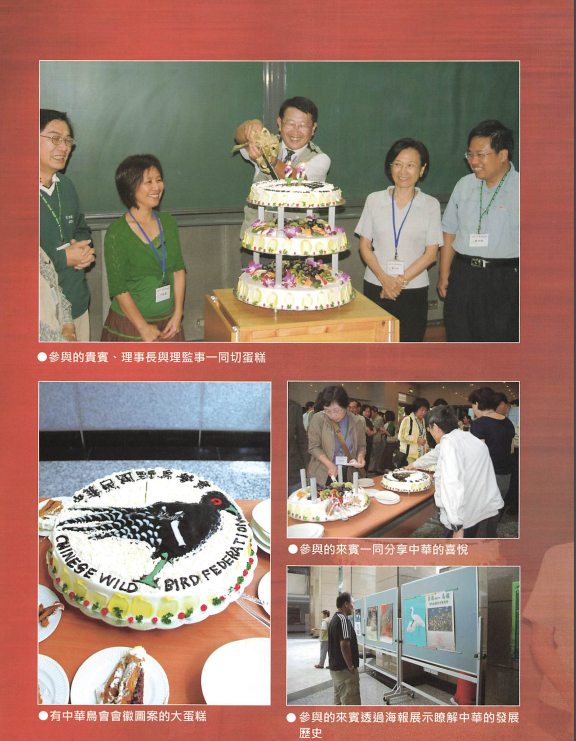
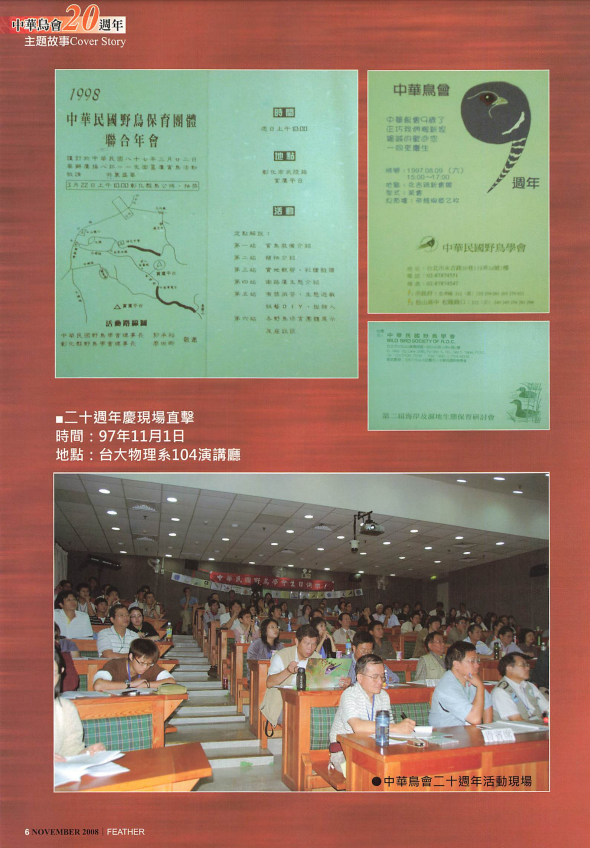
Photos from the TWBF's 20th Anniversary Celebrations and the first Taiwan Bird Forum (Source: Feather Magazine No. 232 Vol. 21)
Another first during this period was the creation of the federation's first birdwatching map. It was released in three languages, Mandarin, English, and Japanese, and was provided to government groups and enterprises. The maps showed 231 birding locations, routes, and wild areas in Taiwan (29).
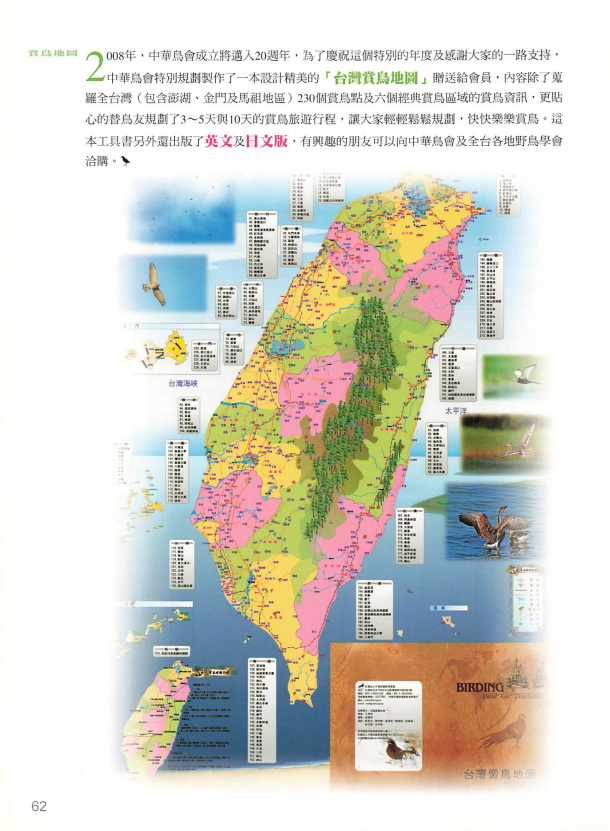
The Taiwan Birdwatching Map created in 2008. (Source: Feather No. 227 Vol. 12)
In 2008 the Wild Bird Society of Penghu left the federation. This took place in response to the group changing its English name back to the Chinese Wild Bird Federation at the request of BirdLife International (5). It still cooperates with WBS Penghu on conservation matters related to breeding terns.
Having come online in 2006, the Taiwan Bird Record Database had by 2008 over 30 years' worth of data, leading to both government agencies and academics requesting data from the federation. This resource proved invaluable as Taiwan moved into the age of citizen science.
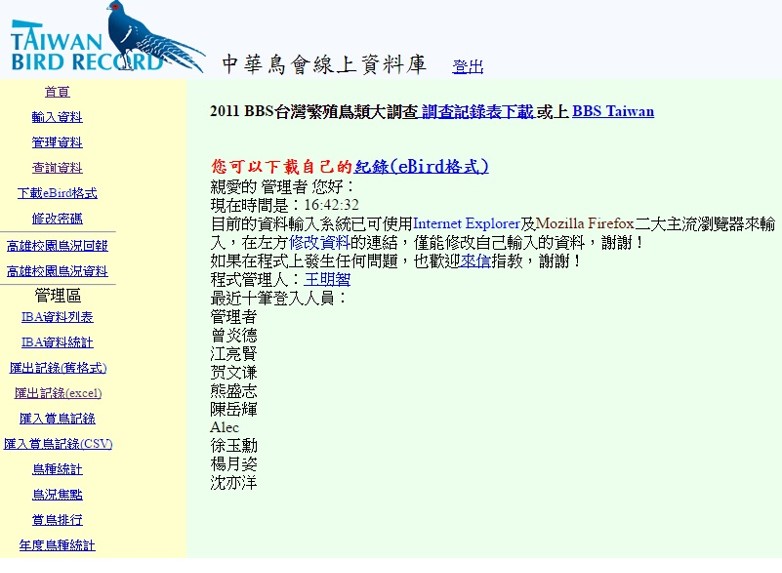
The Interface for the Taiwan Bird Record Database in early 2010s (Source: TWBF Archives)
According to Lyu, Taiwan's citizen science revolution got underway in 2009, with the launch of three different bird-related citizen science projects. The first was the Taiwan Breeding Bird Survey (BBS Taiwan). It was started by the TWBF and the Institute of Ecology and Evolutionary Biology at National Taiwan University with the goal of establishing a breeding bird population index. The BBS Taiwan was pioneering in that it was the first such systematic national-level project in Taiwan and a pioneering BBS for the Asia-Pacific region as well (12). Later, the Taiwan Biodiversity Research Institute joined in the coordination and management of the BBS. Lyu called the project a "game changer." He said, "Before this, we didn't really talk about citizen science or what it is, even though we had the Taiwan Bird Record Database. We weren't linking the science to the people. That concept came from BBS or at least from that time.”
For Lyu, although surveys for the Black-faced Spoonbill and Fairy Pitta were already taking place, these did not count as pure citizen science since there was government funding to support the surveys. To him, "To truly call something citizen science it must be pure volunteering. If the government will give the participants money then it can be considered as more like surveying.”
The second citizen science project to be launched was called the Monitoring Avian Productivity and Survivorship Program, Taiwan (MAPS Taiwan). The project aimed to assess the population structure, productivity, and survivorship of common breeding birds through the banding, ageing, and sexing of individual birds (13). The WBS Yunlin, a TWBF partner, also began to conduct a citizen science project for Northern Lapwings via the Yunlin Northern Lapwing Survey. A winter visitor to Taiwan, thousands forage in the peanut farms of Yunlin in the winter, leading to its local name of "Peanut Bird." In January each year volunteers and researchers conduct surveys to assess abundance. A few years later they would begin coordinating with the TBRI on the project (13).
In 2009, the federation hosted a major international workshop on Birdwatching Tourism in Taiwan. It was supported by the Ministry of Foreign Affairs, the Ministry of the Interior's Construction and Planning Agency, the Taiwan Tourism Bureau and the Taiwan Forestry Bureau (now the Forestery and Nature Conservation Agency). Representatives from all over the region came to discuss birdwatching and its potential for positive change. Speeches were made by representatives from Thailand, Malaysia, Hong Kong, Japan, the Philippines, and Taiwan (2).
Also in 2009 and launched while Yu served as secretary-general of the TWBF, another major birdwatching festival got its start. Yu recalled that, "After helping set up the Taipei International Birdwatching Fair in Guandu and experiencing other bird fairs in the region, I got this idea for an Asian Bird Fair. I talked to friends like those of the Wild Bird Club of the Philippines. 'Since we are all close and we visit so often, why don't we do something bigger like a major event in Asia and showcase it to the world?' Asia is a great place for birding and this would provide the chance for more cross communication.”
In the beginning there were six organizations involved, including the TWBF, the Wild Bird Society of Taipei, Nature Society Singapore, Bird Conservation Society of Thailand, Malaysia Nature Society, and the Wild Bird Club of the Philippines. In Malaysia that same year, an agreement was signed between these members, paving the way for the first Asian Bird Fair to be held in Davao City, Philippines in 2010 (3). Yu explained that the six signatory groups thereafter took turns to host. Later, an executive committee was formed to run the event, and its elected members were Yu, Andrew Sebastian of Malaysia, and Mike Lu of the Philippines. As Yu put it, '2013 was a big changing point. We tried to make it more a formal and prominent international event, which it still is today. It showcases Asia, birdwatching, and friendship to the world.”Now Asia's premier birdwatching festival event takes place in different sites each year and is attended by many different groups. In 2022 it was held in Korea for the first time (1).
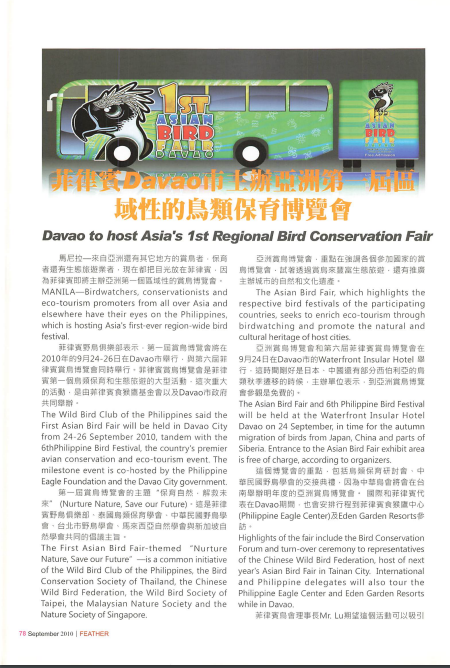
Information on First Asian Bird Fair (Source: Feather No. 243 Vol. 23)
If 2009 could be seen as the birth of the citizen science revolution, 2010 could be seen as the year that Taiwanese ornithology became formalized. That year, the first edition of the Avifauna of Taiwan and the Checklist of the Birds of Taiwan were both published. Avifauna of Taiwan was sponsored by the central government and was the first major work to describe all of Taiwan's species and ornithological history to date. The team behind the book included figures from some of the earliest days of Taiwan bird study such as Dr. Lucia Liu Severinghaus and Yen Chung-wei, as well as professors and top bird experts like Dr. Ding Tzung-su, Dr. Fang Woei-horng, Lin Wen-Horn, and Tsai Mu-chi. The first edition was in Mandarin, and a full English translation followed three years later. A second edition came out in 2017. To this day, it is considered a seminal work on Taiwan's ornithological study (15).
Meanwhile, the creation of the Taiwan Bird Records Committee took place the same year. Yu explained, "the TWBF was charged with the Checklist of the Birds of Taiwan beginning in 1995, I thought that we needed an official committee to address any and all disagreements or discrepancies related to the checklist. So I invited researchers like Dr. Ding Tzung-su of National Taiwan University, Dr. Lin Ruey-shing from the Taiwan Biodiversity Research Institute, and others, six people in total.”
He continued, "It wouldn't be official until the proposal for the committee and founding papers were approved by the federation's Board of Directors and Supervisory Council. So I helped to write the founding documents and it was voted on and approved. People were happy we finally had something like this.”
The first TWBF Checklist of the Birds of Taiwan by the Bird Records Committee of the Taiwan Wild Bird Federation was published in 2010 and featured 576 species. In the preface of the first report, the authors write that the committee had been founded to establish and update the list of birds in Taiwan, and to review newly recorded species in Taiwan (18). They also write that the committee would decide on naming issues, new records, the declaring of new endemics, and other matters. Though they met each year, a new official checklist was released every three years. Finally, there was a checklist and official committee to discuss and rule on Taiwan’s bird records.
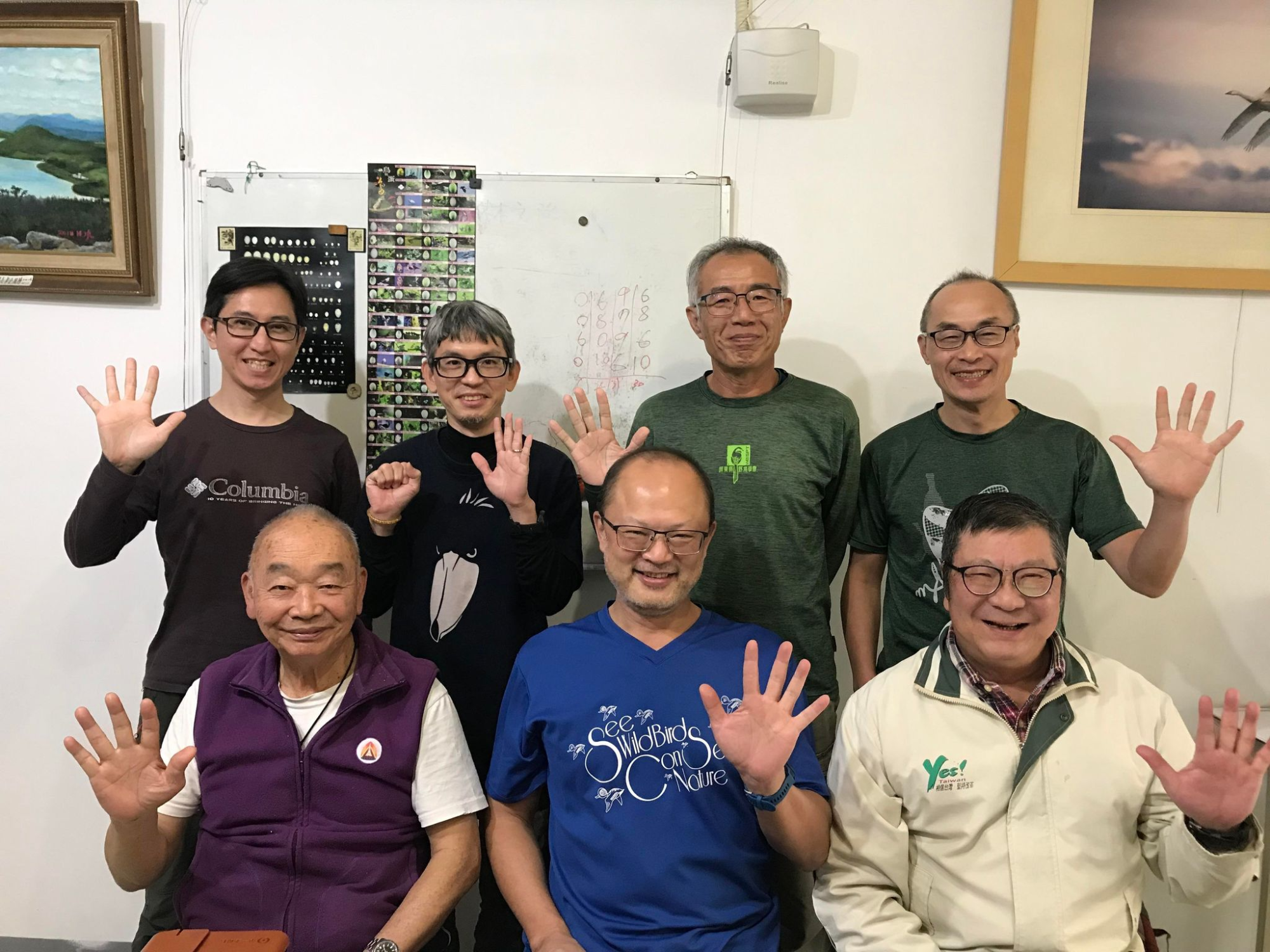
TheTaiwan Wild Bird Federation's Bird Records Committee, February 2023 (Source: TWBF Archives)
The checklist relied heavily on the Taiwan Bird Record Database for occurrence information. The database in turn relied on the birdwatchers and citizen scientists contributing their records to the system. By the 2010s, there were already many well-established university labs and government agencies doing projects or studies related to birds and their conservation. But they still could not replace the bird societies. These maintained their niche by virtue of the communities they created and the network that had been carved out dating back to the '70s and '80s. It was this network and the links between the society members which would help move future surveys and conservation projects forward.
Also that year, with support from industry and government, the federation, BirdLife International, and the BirdLife Asia Division co-hosted the Climate Change and Forests Workshop, which took place from May 9 to 16 alongside the 8th BirdLife Asia Executive Committee Meeting and the 13th BirdLife Asia Council Meeting (17). During the workshop, delegates from BirdLife members and affiliates as well as representatives from regional industry and government agencies discussed BirdLife's Forests of Hope Programme as well as plans to combat the threats of climate change.
A group photo from a session during the Climate Change and Forests Workshop, May 2010 (Source: TWBF Archives)
2011 also saw major actions take place. The first was the publication of Taiwan's Wetlands of Importance. Discussion of identifying Taiwan's most important wetlands began in 2006, with talks headed by the Construction and Planning Agency under the Ministry of the Interior and guided by the RAMSAR Convention (22). Yu represented TWBF on the committee looking to decide which wetlands to include. The report finally came out in 2011. Included were many areas previously listed as IBAs, including Tainan's Sicao and Chiku as well as the Budai Salt Pan Wetlands in Chiayi County (22).
Lastly, the first Dasyueshan International Bird Race, organized by the federation and the Forestry Bureau's Dongshih Forest District Office, took place in April 2011. The birdwatching race, where teams would attempt to count the most bird species in a 24-hour period, took place at the Dasyueshan National Forest Recreation Area. The site is known for being one of Taiwan's best for birding, as the main road winds through the area for 50 km, passing through low, mid- and high elevation forest ecosystems as it goes from Dongshih to the Dasyueshan National Forest Recreation Area. Furthermore, 31 of Taiwan's 32 endemics have been recorded there. The first race saw over 100 participants and included both local and international teams. The winning team recorded 98 species (23). The TWBF co-organized the event for seven years. According to Lyu, "It then passed on to the TWBF partner in Taichung, the Wild Bird Association of Taiwan. They still host the event with the Forestry Bureau today.”
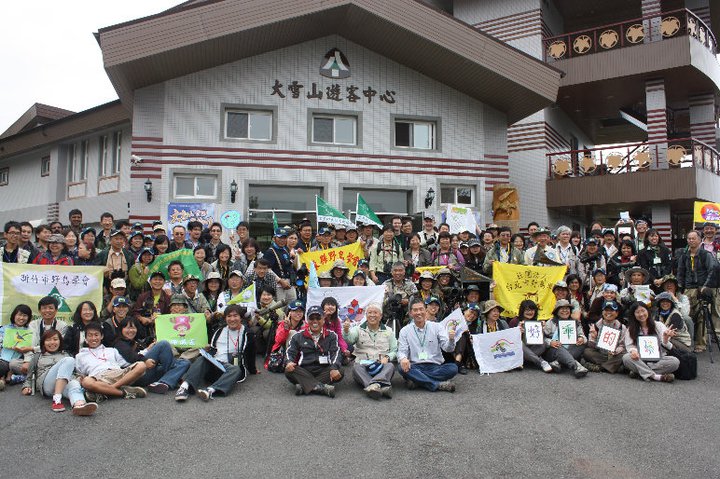
The first Dasyueshan International Bird Race, April 2011 (Souce: TWBF Archives)
This event was not the first birdwatching race held by the Federation. The first to take place was held in January 1996 and was co-organized with the Changhua Wild Bird Society (30). Others include the Kinmen Bird Watching Competition (2007), Yushan Bird Watching Competition (2010), and Jianshi Bird Watching Competition (2014). Today it is the largest international birdwatching race in Taiwan.
Moving Forward and the Citizen Science Revolution (The Early 2010s)
The early 2010s were a period of transition for the TWBF, with new projects being developed and new actions being taken, many related to citizen science. One such project was the Taiwan New Year Bird Count, which started officially in the winter of 2013-2014. A revival of the bird count which took place in the 1970s and 1980s, this citizen science driven project had a two-fold purpose. It was meant to monitor the status and trends of Taiwan's wintering birds and later to supply data for the Asia Waterbird Census.
Current TWBF secretary-general Allen Lyu explained that it was spring of 2013 when talks of re-creating the NYBC took place. The main individuals involved were Dr. Lin Ruey-shing and Dr. Lin Da-li of TBRI, Chuck Kuan-chieh Hung of the TWBF, He Yi-hsien of the WBS Taipei, and Lin Kun-hai of the Kaohsiung WBS. Lyu was added to serve as a coordinator in November 2013. The fledgling project was able to secure NT$50,000 from the Forestry Bureau for outreach. These groups would be the founding organizers, later adding the State of Taiwan's Birds Partnership as well, the group created to develop Taiwan's national bird report.
The Taiwan NYBC follows the rules of the Christmas Bird Count, yet rather than taking place on a single day, it takes place for a month using January 1st as the midpoint. Teams go out to sample sites, with many of those teams comprised of members from the bird societies. The 2013-2014 count had 122 sample sites and 598 volunteers. Over time the event has grown and expanded, and the 2021-2022 count saw 1,032 participants surveying 171 sample circles. This major citizen science project is now going into its 10th year uninterrupted even by the Covid-19 pandemic. The results serve as an important glimpse into the situation facing migratory birds along the East Asian-Australasian Flyway (14). In 2016, the NYBC became the means by which Taiwan would contribute to the Asian Waterbird Census. Former TWBF president Dr. Fang Woei-horng, who had handled the AWC reports since 1987, coordinated with Dr. Lin Ruey-shing of TBRI on this. The collaboration has continued in this way until the present-day.
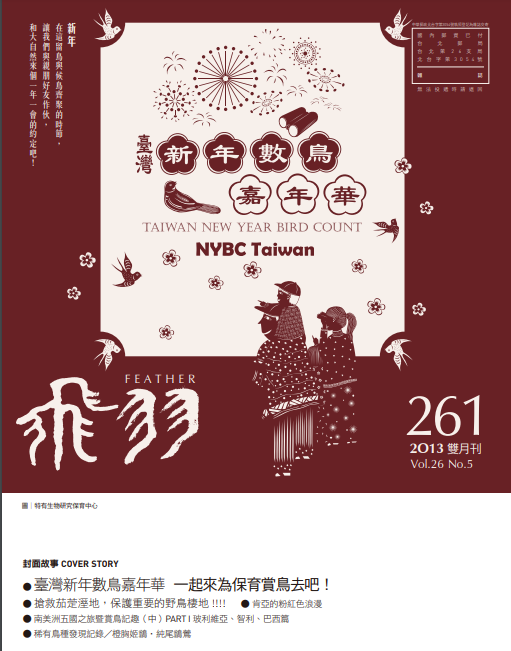
Feather Magazine featuring the First Taiwan NYBC (Source: Feather No. 261 Vol. 26)
Also in 2013, the TWBF, in collaboration with the BirdLife International Marine Programme, the Taiwan Fisheries Agency, and with the support of the International Seafood Sustainability Foundation, hosted another major seabird bycatch workshop for Taiwanese longline fishers (7). During the two-day workshop held in Kaohsiung, international experts from the US, Japan, UK, and BirdLife International shared information on best practices for reducing seabird bycatch in Taiwan’s tuna longline fleet. Demonstrations of practical mitigation measures and implementation techniques were provided. The importance of collecting and reporting data was also highlighted as it would serve as a means to properly understand the impacts of Taiwanese fishing operations on high seas seabird populations. Certain important outcomes of the meeting included an agreement by the TFA to work with the TWBF and BirdLife International Marine Programme on doing educational outreach with Taiwanese fisheries in the Indian Ocean. This was known as Port-based Outreach (PBO). Also, one year after this meeting, the Taiwan Fisheries Agency released a revision to its Taiwan's National Plan of Action for Reducing Incidental Catch of Seabirds in Tuna Longline Fisheries, which first came out in 2006 (20).
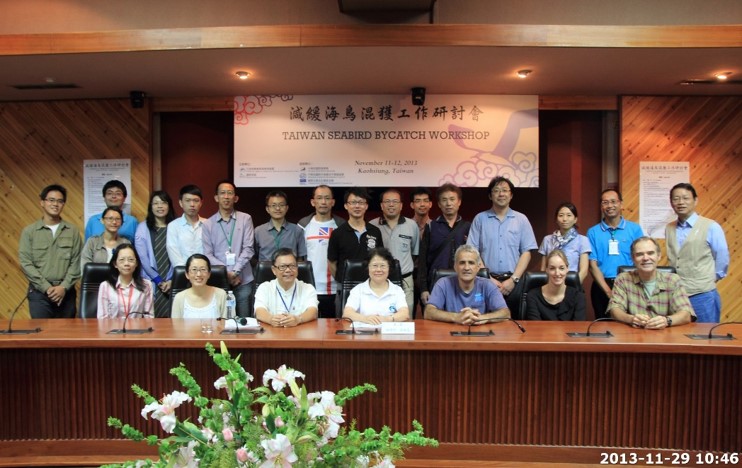
Group Photo from the Taiwan Seabird Bycatch Workshop held in 2013 (Source: TWBF Archives)
This was not the only BirdLife International-related event to be held in Taiwan that year. The 12th BirdLife Asia Council meeting was also held in Kaohsiung from October 24-25, 2013.
After this, of note in 2014 was when the Wild Bird Society of Taipei was asked by the Taiwan Forestry Bureau to help manage the Aogu Forest and Wetland Park based on their fine work with the Guandu Nature Park and the Zhishan Cultural and Ecological Garden (32). The TWBF itself was asked to help manage the Mangrove Ecocenter in New Taipei's Tamsui District and promote education and outreach activities in the period from 2010-2017 (9).
Part 4 will look at today's Taiwan Wild Bird Federation and current actions.
Part 1: A Historical Review of Ornithological Study and Birdwatching Groups in Taiwan
Part 2: The Founding of the TWBF and its Partners and Early Actions (Late 1980s-2000)
References:
(1) Asian Bird Fair. 2023. About ABF. Retrieved 8/9/2023
https://asianbirdfair.org/about/
(2) Chinese Wild Bird Federation. 6/6-7/2009. Conference on Birdwatching Tourism in Taiwan. TWBF Archives
(3) Chinese Wild Bird Federation. 2010. First Asian Bird Festival. 中華飛羽 243 (23)4. Retrieved 9/1/2023.
https://www.bird.org.tw/sites/default/files/field/file/download/%E4%B8%AD%E8%8F%AF%E9%A3%9B%E7%BE%BD-2010-78-242.pdf?fbclid=IwAR0DyJGXWJVgFbBwfbjmlH1qYWNuHhotrf0frwYKEJ7ScZoLXdOgPMuVUfk
(4) Cheng, CC. 2006. Seabird Conservation Education on Board: A Preliminary Training Programme for the Taiwan Longline Fishermen in Port Louis, Mauritius, 2005. Wild Bird Federation Taiwan and Taiwan Fisheries Agency. Retrieved 8/23/2023
https://www.ccsbt.org/system/files/resource/en/4d94fbcf50fbf/19.pdf
(5) Cheng Shu-kai. 9/14/2008. Chinese Manipulation Goes to the Birds. Taipei Times. Retrieved 8/23/2023 https://www.taipeitimes.com/News/taiwan/archives/2008/09/14/2003423161
(6) Chinese Wild Bird Federation. 1997. Schedule for the 1st Taiwan Bird Conference. 中華飛羽 104 (10)4: 1. (中文) Retrieved 8/21/2023
https://www.bird.org.tw/sites/default/files/field/file/download/%E4%B8%AD%E8%8F%AF%E9%A3%9B%E7%BE%BD104%E6%9C%9F-1997-4-%E9%81%AE.pdf?fbclid=IwAR34zjNd0yVMOQiLEhW8gJSdqjDXY4Ut_Bp8cGi7X2oqUUilzND3BuZqlOU
(7) Cooper, J. 11/13/2013. A workshop to protect threatened seabirds in Taiwanese longline fisheries is underway this week. Agreement on the Conservation of Albatross and Petrels. Retrieved 8/11/2023
https://www.acap.aq/news/news-archive/2013-news-archive/a-workshop-to-protect-threatened-seabirds-in-taiwanese-longline-fisheries-is-underway-this-week
(8) Fang, WH. 2005. A Guide to Threatened Birds of Taiwan. Wild Bird Federation Taiwan. Taipei, Taiwan.
(9) Gao, P. 2013. Birding Taiwan. Taiwan Today. Retrieved 8/21/2023
https://taiwantoday.tw/print.php?unit=14&post=23956
(10) Ge You-hao. 12/6/2010. National Highway Number 7 Diverted by Bird Habitat Conservationists. Liberty Times. Retrieved 8/21/2023
https://news.ltn.com.tw/news/local/paper/449924?fbclid=IwAR1m2iPz2767mIOd1gUUzkLLyud84f2Du5IwbnBKhhRHSOk2MZFw1h3g8sk
(11) Guandu Nature Park. 2023. History. Retrieved 8/1/2023
https://gd-park.org.tw/en/history
(12) Lin Da-li and S. Pursner. 2020. State of Taiwan's Birds. Endemic Species Research Institute, Taiwan Wild Bird Federation, Taiwan. Retrieved 8/23/2023
https://www.bird.org.tw/sites/default/files/field/file/report/The%20State%20of%20Taiwan%27s%20Birds_20210129ed.pdf
(13) Lin, Da-li & Pursner, Scott & Ko, Jerome Chie-Jen & Fan, Meng-Wen & Lin, R.S. & Lyu, Allen & Tsai, Shih-Peng & Su, Cynthia. 2019. An Introduction to Taiwan's Citizen Science Projects for Birds. Endemic Species Research Institute. Retrieved 8/23/2023
https://www.researchgate.net/publication/334308262_An_Introduction_to_Taiwan's_Citizen_Science_Projects_for_Birds
(14) Lin, D. L., Tsai, C. Y., Jung, C., Pursner, S., Wang, H. H., Lyu, A., Lin, K. H., Chiang, K. K., & Lin, R. S. (2022). Taiwan New Year Bird Count 2022 Annual Report. Taiwan Wild Bird Federation, Taiwan Endemic Species Research Institute, Taipei, Taiwan. Retrieved 8/11/2023
https://nybc.tw/en/publication/taiwan-new-year-bird-count-2022-annual-report
(15) Lin, Y. 2017.English Version of Avifauna of Taiwan Let's the World See Taiwan. Animal Protection Agency of the Republic of China. Retrieved 8/21/2023
https://www.apatw.org/project-article/7250
(16) Raptor Research Group of Taiwan. 2013. History of the Association. Retrieved 8/28/2023
https://raptor.org.tw/about-rrgt/rrgt-introduce/history.html
(17) Taipei County Government, Chinese Wild Bird Federation, BirdLife international, BirdLife International Asia Division. 2010. 8th Meeting of the BirdLife Asia Exco & 13th BirdLife Asia Council Meeting & Climate Change and Forests Workshop. Chinese Wild Bird Federation. TWBF Archives. https://www.bird.org.tw/sites/default/files/field/file/download/%E4%B8%AD%E8%8F%AF%E9%A3%9B%E7%BE%BD-2010-56-241.pdf?fbclid=IwAR17OFjotfzWMFrqh9YbjWmCocPyNjSKVW58XUK-LmHzP3l3wskSCfOq1wQ
(18) Taiwan Bird Records Committee. 2010. 2010 Checklist of the Birds of Taiwan and Introduction. Chinese Wild Bird Federation. Retrieved 8/9/2023 https://www.bird.org.tw/sites/default/files/field/file/download/2010%E5%8F%B0%E7%81%A3%E9%B3%A5%E9%A1%9E%E5%90%8D%E9%8C%84.pdf
(19) Taiwan Fisheries Agency. 2013. National Report of Taiwan: Ecologically Related Species in the Taiwanese Southern Bluefin Tuna Fishery 2011-2012. Retrieved 8/23/2023 https://www.ccsbt.org/system/files/resource/en/52056d9dd8b79/ERSWG10_AnnualReport_Taiwan.pdf
(20) Taiwan Fisheries Agency. 2020. National Plan of Action for Reducing Incidental Catch of Seabirds in Tuna Longline Fisheries. Retrieved 8/11/2023
https://en.fa.gov.tw/view.php?theme=web_structure&id=165
(21) Taiwan Review. 2006. Scheduled Stopovers. Ministry of Foreign Affairs. Retrieved 8/8/2023
https://taiwantoday.tw/news.php?unit=14&post=22145
(22) Ueng, Yih-tsong, Yang, Ying-chin, Chen Kun-neng. 2011 Taiwan's Wetlands of Importance. Urban And Rural Development Branch, Construction and Planning Agency, Ministry of the Interior.
(23) Wild Bird Association of Taiwan. 2023. Report of the Bird Race Results 2011. Retrieved 8/21/2023. https://www.dasyueshan.org/indexen.php?itemID=59&struID=68
(24) Wild Bird Federation Taiwan 2001. Wild Bird Federation Taiwan Post-Disaster Reconstruction Log. 中華飛羽 158/159 (41)10/11: 4-11. (中文) Retrieved 8/23/2023 https://www.bird.org.tw/sites/default/files/field/file/download/%E4%B8%AD%E8%8F%AF%E9%A3%9B%E7%BE%BD-2001-1011-158.159.pdf?fbclid=IwAR3MhJBAkVQrPxjPs-3s67pHEZhpxlSDmPNHPeEQdySG71YDqCj8mShOXW0
(25) Wild Bird Federation Taiwan. 2002. BirdLife international 7th Asia Council Meeting Report. 中華飛羽 161 (15)1: 4-6. (中文) Retrieved 8/23/2023
https://www.bird.org.tw/sites/default/files/field/file/download/%E4%B8%AD%E8%8F%AF%E9%A3%9B%E7%BE%BD161%E6%9C%9F-2002-1-%E9%81%AE.pdf?fbclid=IwAR1hD0eO6LvVhcJoOCg7Nv7wr3AF476WlYi8M9psYxD6nOJHb9YRI57vEX8
(26) Wild Bird Federation Taiwan. 2002. Reducing Seabird Bycatch in Longline Fisheries. 中華飛羽 171 (15)11: 8-10. (中文) Retrieved 9/20/2023
https://www.bird.org.tw/sites/default/files/field/file/download/%E4%B8%AD%E8%8F%AF%E9%A3%9B%E7%BE%BD-2002-11-171.pdf
(27) Wild Bird Federation Taiwan. 2007. 2007 International Smart Gear Competition Announcement. 中華飛羽 221 (2007)5: 15. (中文) Retrieved 8/23/2023
https://www.bird.org.tw/sites/default/files/field/file/download/221%E6%9C%9F-200705.pdf
(28) Wild Bird Federation Taiwan. 2007. Yehliu Primary School Students Sketch Painting Competition. 中華飛羽 222 (2007)6: 18-19. (中文) Retrieved 8/23/2023
https://www.bird.org.tw/sites/default/files/field/file/download/222%E6%9C%9F-200706.pdf
(29) Wild Bird Federation Taiwan. 2008. Birdwatching Map. 中華飛羽 227 (2008)1: 62-63. (中文) Retrieved 8/23/2023
https://www.bird.org.tw/sites/default/files/field/file/download/%E4%B8%AD%E8%8F%AF%E9%A3%9B%E7%BE%BD-2008-12-227.pdf
(30) Wild Bird Society of the ROC. 1995. Taiwan Year of Birdwatching. 中華飛羽 88 (8)11: 47. (中文) Retrieved 8/23/202
https://www.bird.org.tw/sites/default/files/field/file/download/%E4%B8%AD%E8%8F%AF%E9%A3%9B%E7%BE%BD88%E6%9C%9F-1995-12-%E9%81%AE.pdf?fbclid=IwAR0_NUja0PEnauEKYG6WrWT0_b4rC5vWsWN82WyMegoyqXLa7G_d9Ge177U
(31) Wild Bird Society of Taipei. 7/22/2014. The Story of Yuhina Over Four decades [Video]. YouTube.
https://www.youtube.com/watch?v=Yg6KwjTD7F0
(32) Wild Bird Society of Taipei. 2023. Wild Bird Society of Taipei Entrusted by Forestry Bureau to Operate and Manage the Aogu Wetland Visitor Center (and Guanhai Building). Retrieved on 8/1/2023
https://www.wbst.org.tw/news/350
